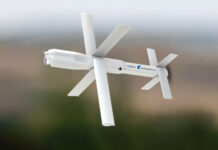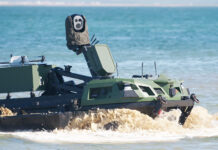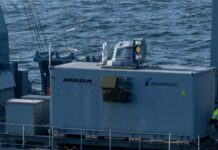On 9 December 2022, Rheinmetall announced that they had been awarded a contract to supply two Skynex very short range air defence (VSHORAD) system batteries to an undisclosed customer. The contract is valued at EUR 182 M, and delivery of the first system is scheduled for the beginning of 2024. The company also added that they had signed a memorandum of understanding (MoU) for the delivery of an unspecified quantity of HX trucks, valued at EUR 12 M to be delivered along with the Skynex systems. The latter suggests the customer has selected the truck-mounted configuration of Skynex.
Skynex is a VSHORAD system of systems which can use a variety of sensors and effectors. In its basic configuration, a Skynex battery consists of four Revolver Gun Mk 3 (RG Mk3) unmanned turrets, the Skynex Control Node 1 (CN-1) command and control (C2) post, and typically an X-TAR3D X-band radar for target search. Rheinmetall are also developing the Multi Sensor Unit (MSU), which combines HD day TV and HD infrared (IR) channels and four fixed active electronically scanned array (AESA) S-band radar panels. The MSU is capable of conducting both target search and fire control functions.
This basic package can be supplemented by a range of options, including other Rheinmetall effectors, such as the RG Mk2, or GDF-009 EO/TREO, an electronic warfare package developed by ELT in Italy, a counter-unmanned aerial vehicle (C-UAV) package from Rheinmetall, and the SkyKnight VSHORAD missile system developed by Halcon. Alternatively, user-defined sensors and effectors, such as those already in service with the user, can be integrated into the Skynex system.
The RG Mk 3 turrets can be either mounted on a demountable hook-liftable platform in their semi-mobile configuration, or on the rear load bed of a truck in its mobile configuration. For engaging small aerial threats, the automatic cannons can be loaded with Rheinmetall AHEAD programmable air burst ammunition.
The working principle behind AHEAD ammunition is to create a small cloud of fast-moving submunitions which provide a much larger probability of striking small targets than a unitary round. To this end, each round is loaded with 152 tungsten sub-projectiles weighing 3.3 g each, and contains a time-based fuze in which the activation time is set during the firing process by a muzzle-mounted ammunition programmer. The fuze activation time is dependent upon the range to the target. As such, when the round is a short distance from the target, the fuze activates a small pyrotechnic charge which opens up the sides of the round and allows the sub-projectiles to be ejected through the centrifugal force of the round’s rotation.
While lacking the range and altitude capabilities of their missile-based counterparts, cannon-based systems nonetheless possess some advantages for VSHORAD applications. For starters, programmable cannon rounds are typically cheaper than their missile counterparts, secondly, they cannot be jammed, in contrast to some missile types, depending on the method of guidance used. Lastly, many missile types will have a larger ‘dead zone’ in which they are unable to engage targets located at ranges very close to the launcher, while for cannons this zone is typically much smaller. While this smaller dead zone is generally not a critical factor when dealing with larger aerial threats such as aircraft and helicopters, it can however be useful in niche tactical scenarios when dealing with smaller threats such as loitering munitions, whose small size and low flight speed allows them to take approaches onto their target which are not possible for many conventional threats.
MC













